| Your browser is not supported. | ||
|
Please browse our site using any of the following options:
| ||
Choosing The Best Hike Food To Take Camping
Hiking is relaxing and invigorating, with stunning views connecting you with nature and loved ones. Whether you're walking for a day or a week, you'll need to take the right food to keep your energy levels up, a smile on your face, and your stomach from rumbling while you're rambling. Here we walk you through the best food for hiking, mountain biking, kayaking and camping trips, the smartest ways to store it all, and how to purify water as well.
What's the best food for hiking and camping?
The answer is different for everyone because it really depends on your particular needs:
- How long you'll be out in nature for (a day, weekend, week, few weeks or longer?)
- How much weight you can carry based on your build and strength (gear, food and water)
- How far you'll be carrying all your food (long distances daily, or will food be kept at camp?)
- Whether you'll be in remote locations (so can't stock up later and need to take all your food)
- How fast your metabolism is (if you burn food fast and get hungry a lot you'll need more food)
- If you have food allergies or dietary requirements (gluten-free, vegetarian, vegan, dairy, nuts)
- What kind of conditions you'll face (if the weather is really cold some stove fuels won't work)
- Whether you're taking the kids (and if you'll have to carry some gear and food for them)
Organising all your food for hiking and camping
Working out what you'll need is easier when you break it down into these seven steps:
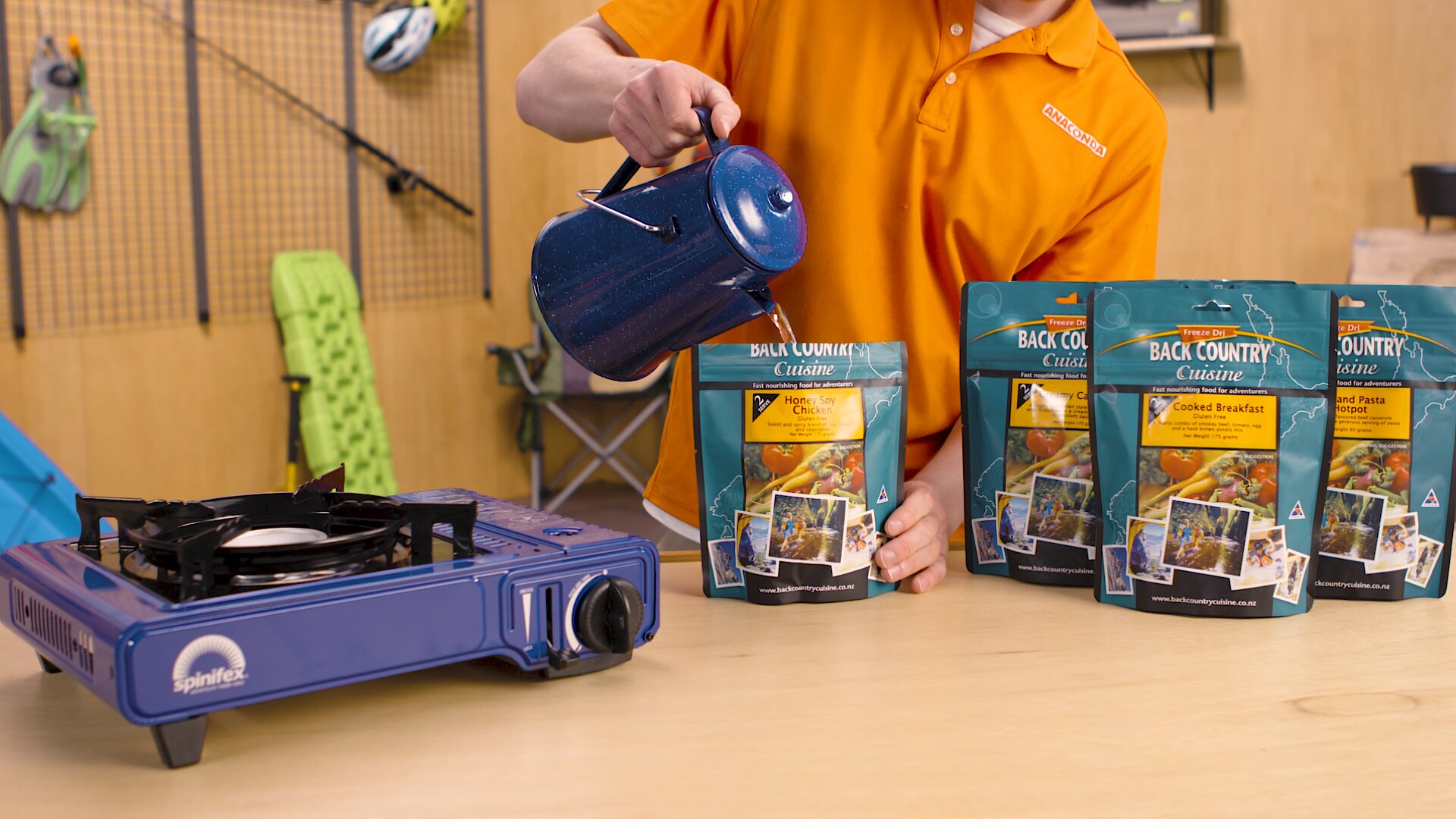
1. Pre-packaged Convenience vs Homemade Effort
When you go hiking you'll use a lot of energy, so it's really important to eat properly.
You'll need:
- Breakfast, lunch, dinner and snacks for each and every day you're hiking or camping.
- To carry more food than you need so you have enough if there's bad weather or an injury.
- Protein-rich snacks for lasting energy between meals, like raw nuts and jerky (dried meat).
You have two different options when it comes to meals:
Pre-Packaged Dehydrated Meals
You can buy nutritious and delicious pre-packaged dehydrated meals from Anaconda:
- They're the quickest and easiest way to prepare for hiking trips and eat well on the trail.
- They're already cooked then dehydrated, so all you do is add purified water to the packet.
Meals You Make at Home
If you want to spend a bit less and you're happy to spend time making meals, you can:
- Prepare your own little bags of muesli, porridge, trail mix, spice blends, pancake mix etc.
- Cook your own meals then use a dehydrator to dehydrate them and add water on the trail.
- Cook and vacuum seal stews, flavoured meats and chillies and store in your camp fridge.
Buying Pre-packaged Dehydrated Food
Packets of dehydrated or freeze-dried meals bought from Anaconda is the easiest option:
- The packets easily fit in your pack and are light to carry if you're hiking, biking or kayaking.
- Just add purified water, leave for 10 minutes, then eat from the packet or tip in a bowl.
- Tasty breakfasts, lunches, dinners, snacks and even smoothies are ready in ten minutes.
- Add purified boiling water for hot dishes, and purified cold water for cold meals and drinks.
- After a long day in the great outdoors, there's nothing better than enjoying good food fast.
- Try Back Country Cuisine roast dinners, hot pots, stir-fries, pastas, soups and breakfasts .
- They even do dehydrated desserts-apple pie, cheesecake and strawberry ice-cream!
- There are also some gluten-free options, vegetarian, vegan, and organic meals options.
- You need to add the right amount of water so take a water bottle with measurement lines.
- If you're travelling light and eating out of the packet, take a spoon with a long handle .
Cooking Your Own Food
Pre-packaged food is the most convenient option, but more expensive than making your own. Your pre-packaged options may also be limited if you have food allergies or dietary restrictions. If you're happy to put time into preparing your meals at home, you can cook everything then:
Dehydrate Meals
You can either:
- Use ingredients that have already been dehydrated to cook such as fruit and nuts or
- Dehydrate your own food and ingredients using your own dehydrating machine at home.
When you dehydrate food it shrinks down and becomes super-light but still super-tasty.
You can dehydrate:
- Sliced fruit (apple and mango chips!) for healthy snacks.
- Veggies (broccoli, carrots, capsicum etc.) for vitamin-and-nutrient-rich dinners.
- Entire meals like stews or cooked ingredients then mix-and-match them each day.
DON'T try to dehydrate chicken, eggs or cheese!
The only issue with making and dehydrating your own food? It can sometimes be a bit chewy.
Vacuum Seal Meals
Vacuum sealing your food:
- Keeps it fresher for longer because it deprives food of oxygen.
- Saves space in storage so you can carry more in your pack.
- Gives flavours time to develop so the food will taste great.
You'll need:
- A vacuum-sealing machine.
- Special plastic vacuum-sealing bags.
Important
Make sure you:
- Always store vacuum-sealed meat and veggies in an ice box, camping fridge or freezer (otherwise bacteria growth can make you sick).
- DON'T take raw meat, especially chicken. Cook and vacuum seal at home, then just reheat.
2. Cooking Equipment
When you're in the great outdoors you can prepare meals with a:
Thermal Pouch
A thermal pouch is a clever alternative to using a camping stove for lightweight hiking:
- Heats up pre-packaged dehydrated meals without hot water (so you don't need a stove).
- Makes meals quick and easy. All you need to do is:
- Add cold water to your dehydrated meal packet then slip it into the thermal pouch.
- Add 50ml of water to activate the heater pack, fold and secure the top with a clip.
- Sit back and relax for about 20 minutes, then enjoy a piping hot meal.
- Heats two single serves or one double serve of a pre-packaged dehydrated meal packet.
- Can be used in total fire ban areas where an exposed flame of any kind can pose risks.
- Is bushfire safe and only requires water and a spoon to make hot meals.
- Keeps your meals piping hot in cold weather (and comes with a long spoon).
Gas Stove
The gas used to fuel a little portable stove comes in different:
- Weights so choose one you can carry comfortably (along with all your gear).
- Fuel types
- Butane - these single-use disposable cartridges are lightweight but don't burn very well in the cold.
- Isobutane - these single-use containers are the lightest so easiest to carry, but you'll need to carry one container for each meal.
Important
Make sure you:
- Take enough fuel-the longer things take to cook, the more fuel you'll need.
- Check campsite rules before you go-some places only let you cook with gas stoves, others allow you to cook on an open fire.
To learn more go to the Camping Cooking Buying Guide and browse camp cooking equipment.
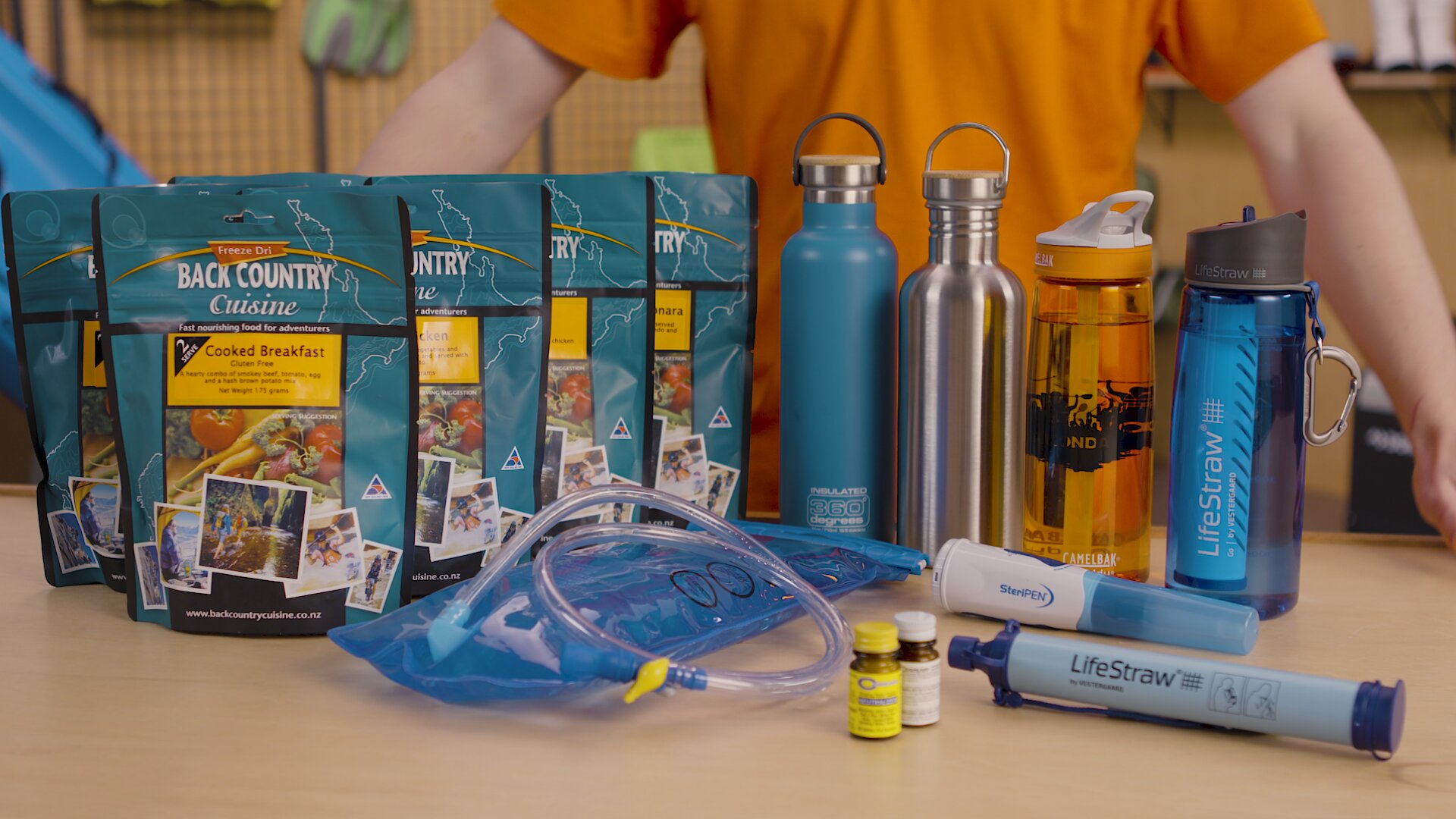
3. Meal & Snack Ideas
There are lots of delicious things you can have for meals and snacks. Here are a few ideas:
Breakfast
You could have:
- Cereal with powdered milk (porridge with dried fruit, Weetbix etc.)
- Baked beans (tins are heavy and you have to carry empties home), dried beans are lighter
- Pancakes (your own mix or an instant store-bought mix you just have to add water to)
Lunch
You could have:
- A wrap or bread with:
- Your favourite spread (vegemite, peanut butter, jam, honey or Nutella)
- Tuna, salmon or sardines (sachets are lighter than tins)
- Salami or Parma ham
- Cheese (only hard cheeses like cheddar or gouda to avoid mould)
- Sun dried tomatoes
- Pre-packaged dehydrated meals like couscous
- An assortment of snack foods like nuts, crackers and jerky
Dinner
You could have:
- Pastas, stews or curries with fast-cooking rice or noodles, or instant mashed potatoes
- Roast dinners, stir-fries or soups
- Small ziplocked bags of sauces, olive oil, salt and pepper, herb flakes, spice mixes, sweeteners to add extra flavour to your meals too
Snacks
You could have:
- Nuts, seeds or trail mix
- Crackers (with nut butter) or biscuits
- Jerky (dried meat)
- Chocolate or lollies
- Muesli or fruit bars
- Energy gels, bars, balls
Sports drinks that replace electrolytes lost through sweating
It's not worth taking bananas and other fresh fruit-it'll just end up squashed in your bag.
Hot Drinks
You could have (with or without powdered milk and sugar/sweetener):
- Tea and coffee (check out Anaconda's mini coffee makers)
- Hot chocolate or milo
- Cuppa soups
Don't forget to:
- Bring good oil or fat, like coconut or olive oil if you plan to fry anything.
- Wash or sanitise your hands before you cook and eat so you don't get sick!
4. Amount
When it comes to how much food you need to take:
- You want to take slightly more than you need in case of bad weather or injury delays.
- You want to make sure you've got enough but not too much.
- You don't want to be lugging around way more food than you need.
- It can't be too heavy for you to carry (along with all your other gear).
You should also take food that keeps you feeling full for as long as possible:
- This gives you the best bang for your buck (the most value for the space it takes up).
- Protein-rich food gives you lasting energy, fills you up and can help with muscle recovery.
- Balance the nutrients so you get enough protein, fat and carbohydrates (including sugars).
The weight of the food you take should be:
- Carefully thought out-you'll be carrying it on your back if you're hiking for days or weeks.
- Between about 700g and 1kg per person per day (it varies from person to person).
- In line with the calories you need to eat to replace the energy you're burning through.
Counting up how many calories you'll need:
- People burn different amounts of calories depending on their activities and bodies.
- In everyday life, most people need to eat about 1600-2400 calories a day .
- When you're hiking, you could burn double the amount of calories or more.
- On the trail you'll eat more sugar and fat to give you the calories you need.
- Go for food with lots of calories that doesn't weigh much or take up much space.
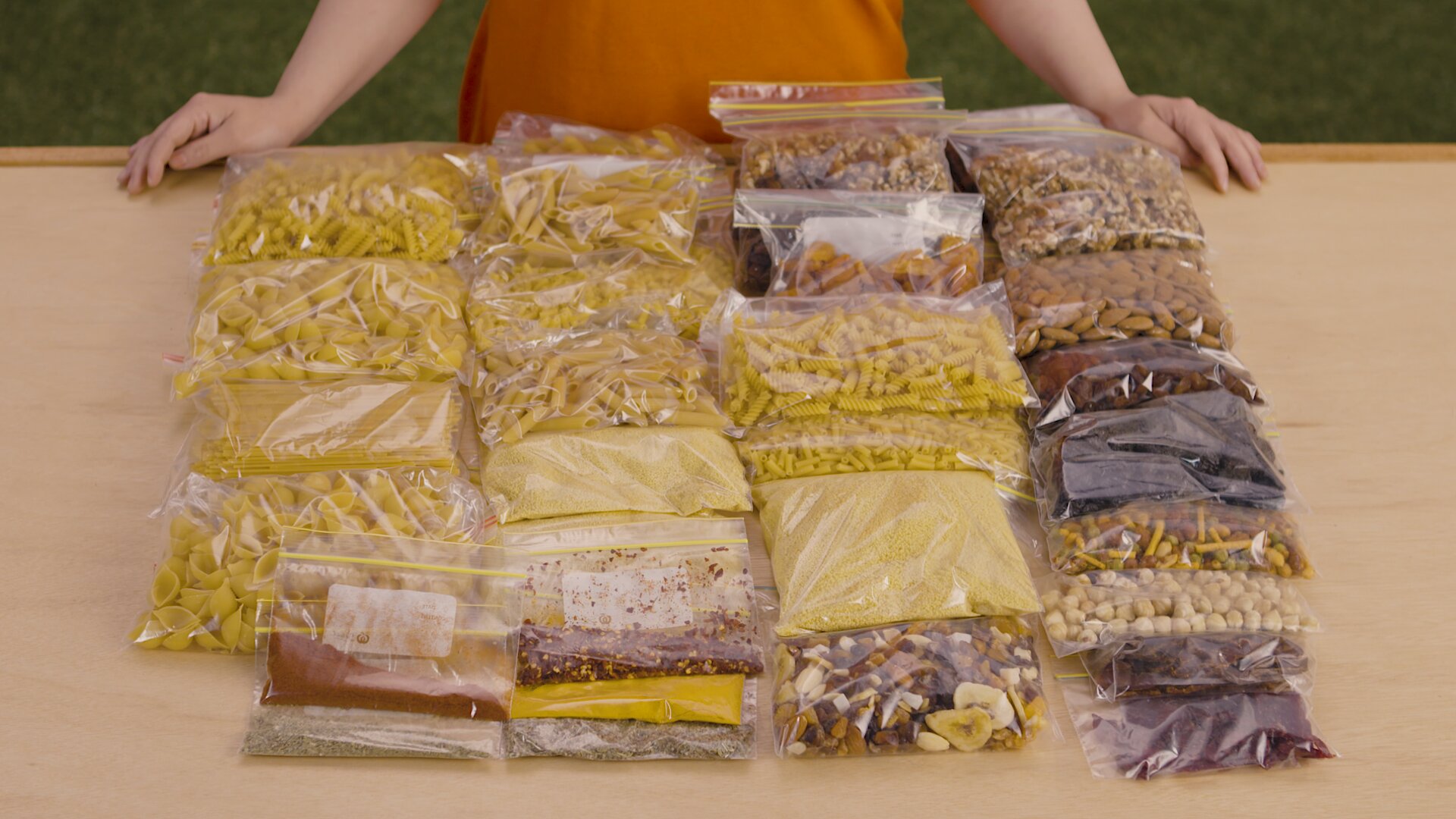
5. Storage
The storage you choose for your food should be:
- As lightweight as possible so it doesn't weigh you down.
- Compact in size so it doesn't add too much bulk.
- Easy for you to carry-especially if you're backpacking.
- Tightly sealed so bugs, rats, mice and wildlife can't get into it.
The best way to store food:
- Use zip-lock bags-they're lightweight and don't take up more space than the food does:
- Small ones are good for herbs and spices.
- Large ones for nuts and seeds, pasta, couscous, and any pre-mixes you make.
- Put crackers or biscuits in hard containers so they don't turn into a pouch of crumbs!
- Put olive oil, salad dressing or soy sauce in small bottles (don't carry the whole bottle).
- Label zip-lock bags with a day and meal number (Day 1 - 1=breakfast, 2=lunch, 3=dinner).
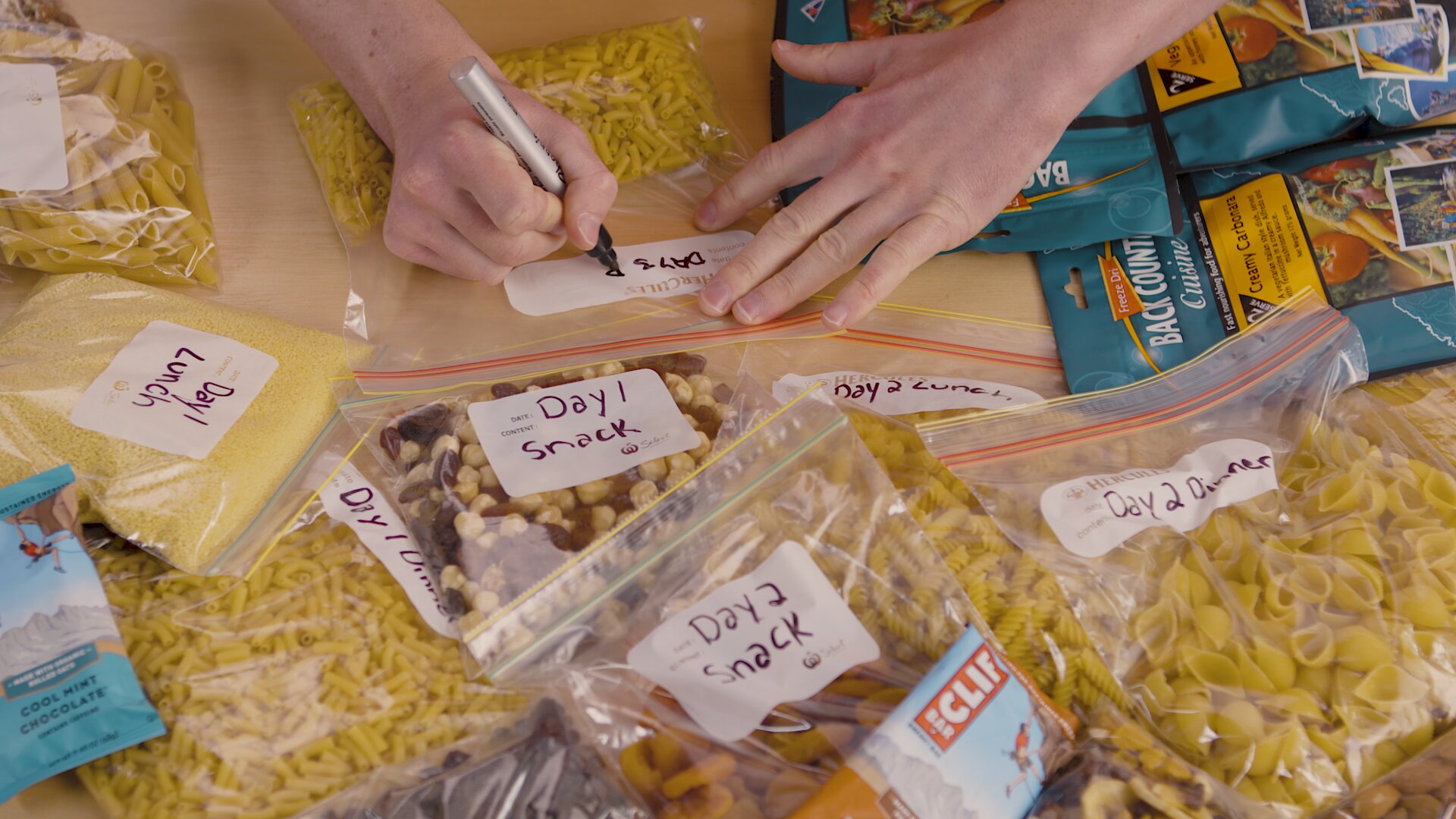
6. Water
You'll need to carry enough purified water for:
- Making meals, whether you're using a thermal pouch for dehydrated packets or a stove.
- Drinking every day so you stay hydrated, especially if you're really working up a sweat.
Make sure you take either a:
Water Bottle
- Plastic water bottles are durable and lightweight.
- Steel water bottles insulate your water so it stays cool, even on hot days.
Water Bladder
- Takes up less space in your backpack than bottles.
- Have a convenient sipping straw for quick and easy drinking.
For Short Day Hikes
- Carry enough clean water to last the journey.
- Most of the time, 3L should be enough.
- If you'll be working up a sweat or the weather will be hot, carry more.
For Longer or Multi-Day Hikes
You won't be able to fit all the water you'll need in your pack.
You'll need to:
- Take a water purification method.
- Collect water from taps and rivers on the way.
- Purify the water to remove bacteria and debris.
There are four ways you can purify water you collect from taps, streams or rivers:
Boiling Water
- An effective way to kill bacteria, but you'll need a stove and fuel so this method.
- Best for multi-day hikes as you'll need to take a stove and fuel for cooking anyway.
Filter Botles & Straws
- Simple and convenient.
- You'll need another purification method for teeth cleaning and washing dishes.
Tablets & Liquids
- Lightweight and easy-to-use but can take up to 30 minutes to work.
- You may be left with the slight taste of chlorine.
Shop Water Purification Storage
UV Lights
- Take longer to work (depending on how much water you have).
- You need to carry spare batteries for it.
- Can only be used with a water bottle (not a water bladder).
Always check the signs at camp sites and on trails to see if the water is safe to drink.
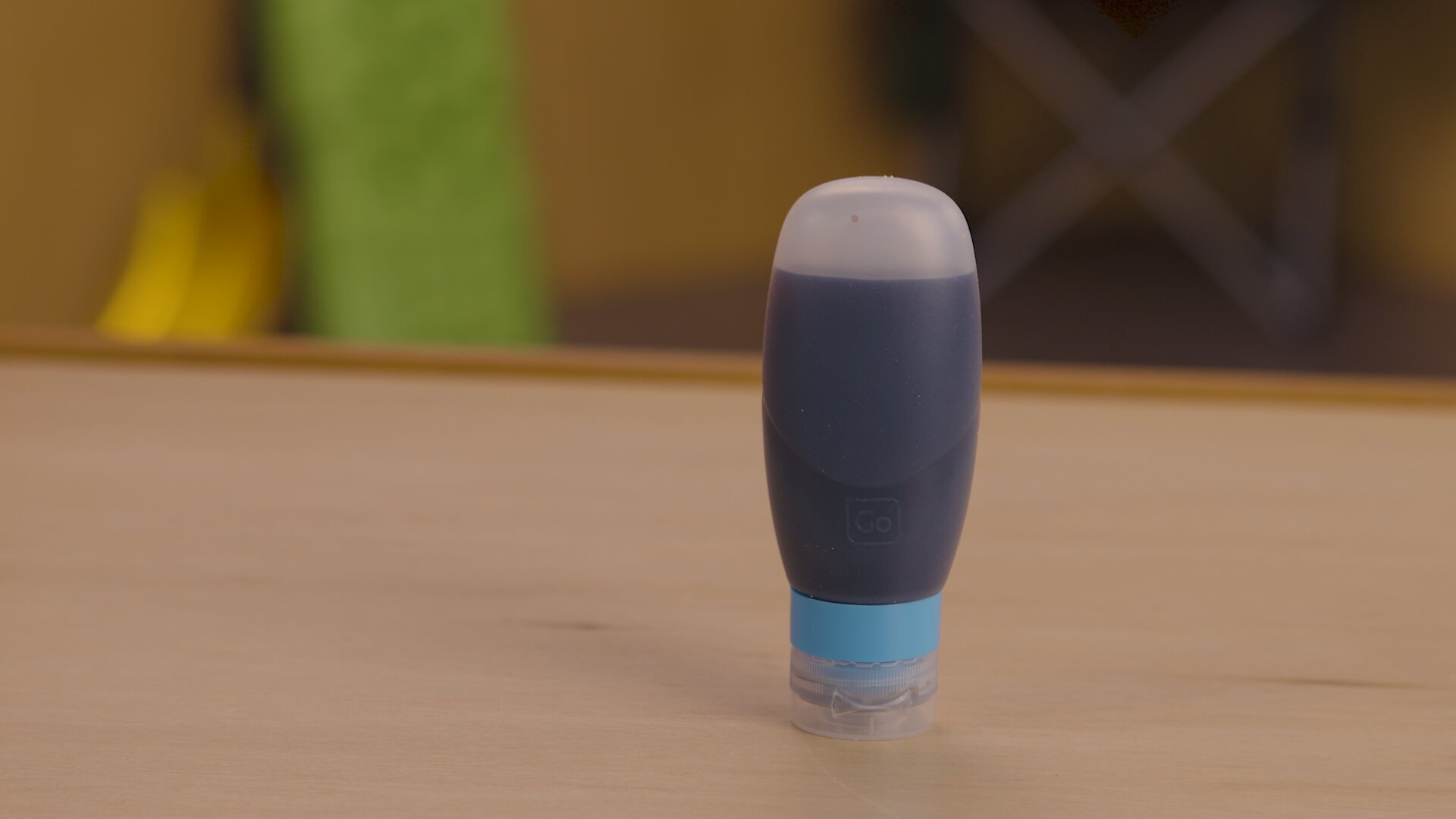
7. Convenience & Cost
When you're weighing up which food options to go with, think about effort versus cost:
- Pre-packaged dehydrated food packets are the easiest and lightest option but cost more.
- Cooking, dehydrating or vacuum sealing your own food saves money but takes more effort.
- After a long day of hiking, biking or kayaking how much energy will you have to cook?
When you go to the Anaconda website, select Camping & Hiking from the menu along the top, then Camp Cooking/Outdoor Diningg, then Camp Food. You'll then see tick box filters down the left hand side of the page which make working out what to buy easier and faster because you can choose to filter the food you see by:
- Size - so you just see single serves for one, double portions for two, or packs that feed five.
- Deal - so you only see food that's on sale or at clearance prices.
- Brand - so you can find a specific brand you like.
For more help choosing food for hiking, biking, kayaking or camping, drop into an Anaconda store.
We'll help you get the right food and storage solutions sorted for your trip.
Other Camping & Hiking Essentials
Check out Anaconda's range of Camping & Hiking products available online or visit your local store.